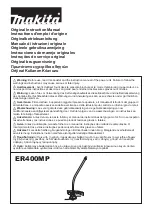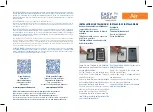
152
For loose coatings, wipe with a cloth. Use a bottle brush to clean out the internal channels.
For removal of scale, dip in a dilute hydrochloric or gallic acid solution, and rinse.
The electrodeless sensor is immune to oily coatings.
Reassemble all parts. Make sure that the sample valve is closed, open the isolation valves, and
inspect for leaks.
After cleaning, it is necessary to recalibrate the electrode. This is only accurate when the electrode
is installed in the piping.
7.3
pH Electrode Cleaning and Calibration
The frequency of cleaning for the pH electrode varies with each installation. The best way to
determine the frequency is to compare the reading of the controller to the reading of a calibrated
hand held instrument. When the two readings differ by an amount that you deem to be excessive
(perhaps 0.5 pH units), then it time to clean and recalibrate the electrode. This should be every 2-3
months.
To clean the pH electrode, close the isolation valves to stop sample flow. Open the sample valve to
relieve the pressure in the manifold. Remove the nut that holds the electrode in place. Pull the
electrode straight up and out.
For loose coatings, wipe with a cloth. Avoid rough handling of the pH sensitive glass.
For removal of scale, dip in a dilute hydrochloric or gallic acid solution, and rinse.
For oils (including fingerprints!) wash with a detergent or isopropyl alcohol.
Reassemble all parts. Make sure that the sample valve is closed, open the isolation valves, and
inspect for leaks.
After cleaning, it is necessary to recalibrate the electrode. Refer to Section 6.5 for detailed
calibration instructions.
7.4
ORP Electrode Cleaning and Calibration
The frequency of cleaning for the ORP electrode varies with each installation. The best way to
determine the frequency is to verify that the desired oxidizer concentration is within your required
limits when the controller indicates that the ORP is at the set point value. The frequency of
cleaning should be every 2-3 months or so.
To clean the ORP electrode, close the isolation valves to stop sample flow. Open the sample valve
to relieve the pressure in the manifold. Remove the nut that holds the electrode in place. Pull the
electrode straight up and out.
For loose coatings, wipe the platinum tip with a cloth.
For removal of scale, dip in a dilute hydrochloric or sulfuric acid solution, and rinse.
For oils (including fingerprints!) wash with a detergent or isopropyl alcohol.
For very stubborn coatings, jeweler’s rouge may be used to polish the platinum tip.
Reassemble all parts. Make sure that the sample valve is closed, open the isolation valves, and
inspect for leaks.
After cleaning, it is necessary to recalibrate the electrode. Refer to Section 6.6 for detailed
calibration instructions.
Содержание WebMaster
Страница 19: ...15 Figure 1a Typical Installation Cooling Tower ...
Страница 20: ...16 Figure 1b Typical Installation Boiler Intermittent Sampling ...
Страница 21: ...17 Figure 1c Typical Installation Boiler Continuous Sampling ...
Страница 30: ...26 Figure 7 Wiring Diagram for Optional Digital Communications ...
















































